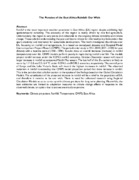| dc.contributor.author | Ongoma, Victor | |
| dc.contributor.author | Ngaina, Joshua | |
| dc.contributor.author | Oduke, Willy | |
| dc.date.accessioned | 2019-04-03T06:32:20Z | |
| dc.date.available | 2019-04-03T06:32:20Z | |
| dc.date.issued | 2018-06-12 | |
| dc.identifier.issn | ISBN: ISBN: 978-9966-59-011-5 | |
| dc.identifier.uri | http://erepository.kibu.ac.ke/handle/123456789/585 | |
| dc.description.abstract | Rainfall is the most important weather parameter in East Africa (EA) region despite exhibiting high spatiotemporal variability. The economy of the region is mainly driven by rain fed agriculture. Unfortunately, the region is very prone and vulnerable to the ongoing climate variability and climate change. These calls for understanding the past and future climate for informed policy formulation that spurs creativity and innovation for sustainable development. This work investigates the climate over EA, focussing on rainfall and temperature. It is based on reanalyzed datasets and Coupled Model Intercomparison Project Phase 5 (CMIP5). The period under study is 1951-2010 (2071–2100) for past (future) with a baseline period (1961–1990). Results show an overall decrease (increase) in rainfall (temperature) over EA. CMIP5 models perform poorly in reproducing rainfall over EA. The models project rainfall increase under the RCP4.5 and 8.5 scenarios. October-December season will record larger increase in rainfall as compared March-May season. The last half of the 21st century is likely to warm by 1.7–2.8 and 2.2–5.4 °C under RCP4.5 and RCP8.5 scenarios, respectively. The central parts of Kenya and the Lake Victoria Basin will record the highest increases in rainfall. The observed reduction in rainfall is extending into CMIP5 model projection period that show increase in rainfall. This is the paradox that calls for caution in the uptake of the findings based on the Global Circulation Models. The actualization of the projected increase in rainfall will be a relief to the population of EA, and therefore it remains to be our wish. There is need for advanced research using Regional Circulation Models so as to come up with climate products for long term planning. Meanwhile, the best advisories are limited to adaptation measures to climate change effects in response to the observed climate, an option that is socioeconomically expensive. | en_US |
| dc.language.iso | en | en_US |
| dc.publisher | KIBU | en_US |
| dc.rights | Attribution-NonCommercial-ShareAlike 3.0 United States | * |
| dc.rights.uri | http://creativecommons.org/licenses/by-nc-sa/3.0/us/ | * |
| dc.subject | Climate projection | en_US |
| dc.subject | Rainfall | en_US |
| dc.subject | Temperature | en_US |
| dc.subject | CMIP5 | en_US |
| dc.subject | East Africa | en_US |
| dc.title | The paradox of the East Africa rainfall: our wish | en_US |
| dc.type | Other | en_US |

